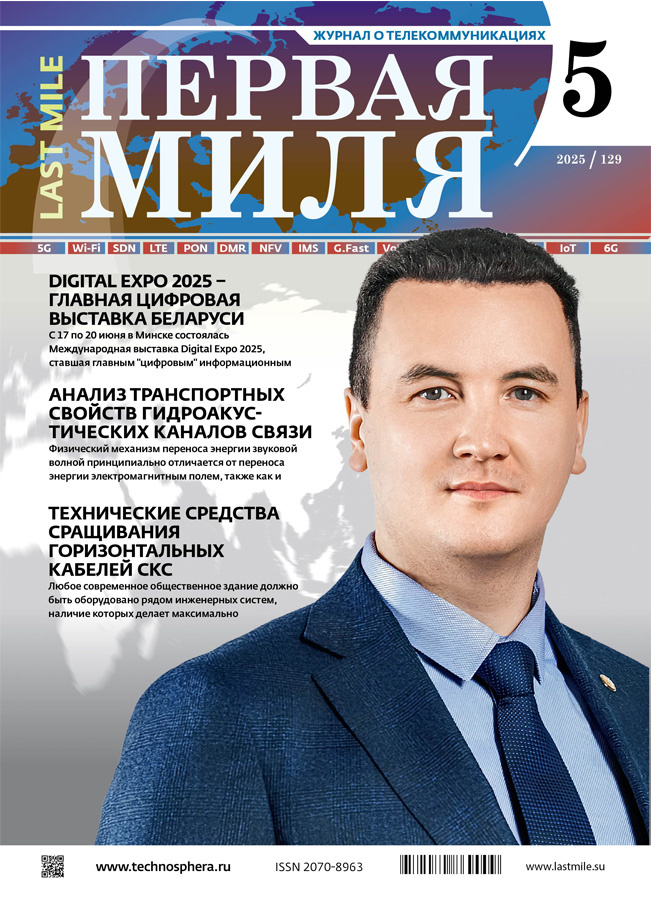Analysis of the transport properties of hydroacoustic communication channels
- Authors: Shavrin S.S.1, Musatova O.Y.1
-
Affiliations:
- Moscow Technical University of Communications and Informatics
- Issue: No 5 (2025)
- Pages: 36-41
- Section: СЕТЕВАЯ ИНФРАСТРУКТУРА
- URL: https://journals.eco-vector.com/2070-8963/article/view/688746
- DOI: https://doi.org/10.22184/2070-8963.2025.129.5.36.41
- ID: 688746
Cite item
Abstract
The paper aim is to analyze water as a transmission medium influence on the transport properties of ultrasonic channels and their throughput potential development. The main destructive factors group influence on channel characteristics such as the energy budget, impulse response nonstationarity and its precorrection effectiveness, the sound focusing tools using efficiency, the Doppler effect reveal and signal-code construction choice are being analyzed.
Full Text
About the authors
S. S. Shavrin
Moscow Technical University of Communications and Informatics
Author for correspondence.
Email: sss@mtuci.ru
д.т.н., проф.
Russian Federation, MoscowO. Yu. Musatova
Moscow Technical University of Communications and Informatics
Email: sss@mtuci.ru
ст. преподаватель
Russian Federation, MoscowReferences
- Фокин Г.А. и др. Акустические и вихревые поля в водосодержащих системах. Пенза: ПГУАС, 2013. 260 с.
- Смирнов И.В., Михайлова Н.В., Якупов Б.А., Волков Г.А. Анализ пороговых параметров начала акустической кавитации жидкости в зависимости от частоты ультразвукового поля, гидростатического давления и температуры // Журнал технической физики. 2021. Т. 91. Вып. 11.
- Промтов М.А. Кавитация. Тамбов: Тамбовский государственный технический университет, 2006.
- Макаров А.И., Дворников В.Д., Конопелько В.К. Передача информации в гидроакустическом канале // Доклады Белорусского государственного университета информатики и радиоэлектроники. 2004. № 2.
- Thanh Nguyen T., Asakura Y., Koda S., Yasuda K. Dependence of cavitation, chemical effect, and mechanical effect thresholds on ultrasonic frequency [Электронный ресурс]. URL: https://www.researchgate.net/publication/316529297_Dependence_of_Cavitation_Chemical_Effect_and_Mechanical_Effect_Thresholds_on_Ultrasonic_Frequency (дата обращения 25.06.2025).
- Sponer J. Dependence of the cavitation threshold on the ultrasonic frequency // Czechoslovak Journal of Physics 1990. Vol. 40. PP. 1123–1132.
- Brotchie A., Grieser F., Ashokkumar M. Effect of Power and Frequency on Bubble-Size Distributions in Acoustic Cavitation Phys. Rev. Lett. 2009. Vol. 102. No. 8. P. 084302.
- Шаврин С.С., Липатов А.А., Мусатова О.Ю. Динамика деформации сигнала, вызванной эффектом Доплера, в низкоорбитальных спутниковых системах // Электросвязь. 2022. № 11. С. 34–40.
- Унру П.П., Стаценко Л.Г., Родионов А.Ю. Адаптивный подход к помехоустойчивому кодированию с малой плотностью проверок на четность в гидроакустических системах связи // Вестник инженерной школы ДВФУ. 2022. № 2 (51). С. 69–80.
- Малахов И.М., Шаврин С.С. Анализ импульсных характеристик Watermark Benchmark для моделирования подводных акустических каналов связи // Электросвязь. 2025. № 3. С. 50–55.
- Dushin S.V., Shavrin S.S., Kurov I.Y., Aleshin V.S., Farkhadov M.P. Multicarrier modulation schemes efficiency investigation in swallow water hydroacoustic communication application // 2020 International Conference on Engineering and Telecommunication (En&T), Proceedings. 2020. 9431262.
- Dushin S.V., Malakhov I.M., Kurov I.Y., Shavrin S.S. Adaptive Equalization Algorithms Efficiency Investigations in Hydroacoustic Communication Applications with FBMC Modulation // 2021 Systems of signals generating and processing in the field of on board communications. IEEE Conference No 51389. DSPA.
Supplementary files
Supplementary Files
Action
1.
JATS XML
2.
Fig. 1. Results of experiments in the North Atlantic at water temperature T = 4 °C and acidity pH = 8.0 [4]
Download (313KB)
3.
Fig. 2. Experimental results in the Red Sea at water temperature T = 22 °C and acidity pH = 8.2 [4]
Download (295KB)
4.
Fig. 3. Threshold negative pressure for the onset of cavitation P as a function of ultrasound frequency f: 1 - data from [5]; 2 - data from [6]
Download (173KB)
5.
Fig. 4. Dependence between the radii of nuclei that can participate in the process of cavitation initiation and the ultrasound frequency
Download (236KB)









